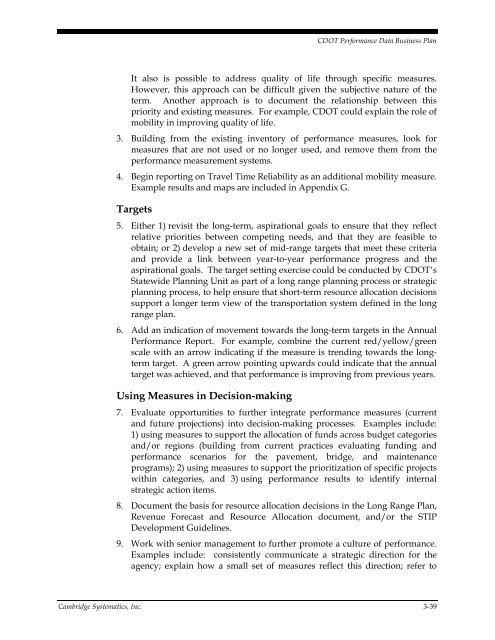CDOT Performance Data Business Plan - Cambridge Systematics
CDOT Performance Data Business Plan - Cambridge Systematics
CDOT Performance Data Business Plan - Cambridge Systematics
Create successful ePaper yourself
Turn your PDF publications into a flip-book with our unique Google optimized e-Paper software.
<strong>CDOT</strong> <strong>Performance</strong> <strong>Data</strong> <strong>Business</strong> <strong>Plan</strong><br />
It also is possible to address quality of life through specific measures.<br />
However, this approach can be difficult given the subjective nature of the<br />
term. Another approach is to document the relationship between this<br />
priority and existing measures. For example, <strong>CDOT</strong> could explain the role of<br />
mobility in improving quality of life.<br />
3. Building from the existing inventory of performance measures, look for<br />
measures that are not used or no longer used, and remove them from the<br />
performance measurement systems.<br />
4. Begin reporting on Travel Time Reliability as an additional mobility measure.<br />
Example results and maps are included in Appendix G.<br />
Targets<br />
5. Either 1) revisit the long-term, aspirational goals to ensure that they reflect<br />
relative priorities between competing needs, and that they are feasible to<br />
obtain; or 2) develop a new set of mid-range targets that meet these criteria<br />
and provide a link between year-to-year performance progress and the<br />
aspirational goals. The target setting exercise could be conducted by <strong>CDOT</strong>’s<br />
Statewide <strong>Plan</strong>ning Unit as part of a long range planning process or strategic<br />
planning process, to help ensure that short-term resource allocation decisions<br />
support a longer term view of the transportation system defined in the long<br />
range plan.<br />
6. Add an indication of movement towards the long-term targets in the Annual<br />
<strong>Performance</strong> Report. For example, combine the current red/yellow/green<br />
scale with an arrow indicating if the measure is trending towards the longterm<br />
target. A green arrow pointing upwards could indicate that the annual<br />
target was achieved, and that performance is improving from previous years.<br />
Using Measures in Decision-making<br />
7. Evaluate opportunities to further integrate performance measures (current<br />
and future projections) into decision-making processes. Examples include:<br />
1) using measures to support the allocation of funds across budget categories<br />
and/or regions (building from current practices evaluating funding and<br />
performance scenarios for the pavement, bridge, and maintenance<br />
programs); 2) using measures to support the prioritization of specific projects<br />
within categories, and 3) using performance results to identify internal<br />
strategic action items.<br />
8. Document the basis for resource allocation decisions in the Long Range <strong>Plan</strong>,<br />
Revenue Forecast and Resource Allocation document, and/or the STIP<br />
Development Guidelines.<br />
9. Work with senior management to further promote a culture of performance.<br />
Examples include: consistently communicate a strategic direction for the<br />
agency; explain how a small set of measures reflect this direction; refer to<br />
<strong>Cambridge</strong> <strong>Systematics</strong>, Inc. 3-39

















